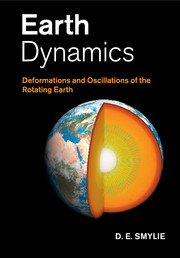Book contents
- Frontmatter
- Contents
- Preface and acknowledgments
- The book website www.cambridge.org/smylie
- 1 Introduction and theoretical background
- 2 Time sequence and spectral analysis
- 3 Earth deformations
- 4 Earth's rotation: observations and theory
- 5 Earth's figure and gravitation
- 6 Rotating fluids and the outer core
- 7 The subseismic equation and boundary conditions
- 8 Variational methods and core modes
- 9 Static deformations and dislocation theory
- Appendix A Elementary results from vector analysis
- Appendix B Properties of Legendre functions
- Appendix C Numerical Earth models
- References
- Fortran index
- Subject index
1 - Introduction and theoretical background
Published online by Cambridge University Press: 05 March 2013
- Frontmatter
- Contents
- Preface and acknowledgments
- The book website www.cambridge.org/smylie
- 1 Introduction and theoretical background
- 2 Time sequence and spectral analysis
- 3 Earth deformations
- 4 Earth's rotation: observations and theory
- 5 Earth's figure and gravitation
- 6 Rotating fluids and the outer core
- 7 The subseismic equation and boundary conditions
- 8 Variational methods and core modes
- 9 Static deformations and dislocation theory
- Appendix A Elementary results from vector analysis
- Appendix B Properties of Legendre functions
- Appendix C Numerical Earth models
- References
- Fortran index
- Subject index
Summary
The Earth's dynamical behaviour is a complex and fascinating subject with many practical ramifications. Its description requires the language of mathematics and computation. In this book, we attempt to make the theoretical foundations of the description of Earth's dynamics as complete as possible, and we accompany the theoretical descriptions with computer code and graphics for the implementation of the theory.
Scalar, vector and tensor analysis
We will make extensive use of scalars, vectors and tensors throughout the book. In this section, we will summarise the properties most often used. It is assumed that the reader is familiar with the elementary results of vector analysis summarised in Appendix A.
Scalars
Physical quantities determined by a single number such as mass, temperature and energy are scalars. Scalars are invariants under a change of co-ordinates, they remain the same in all co-ordinate systems. They are sometimes simply referred to as invariants. A scalar field is a function of space and time.
Vectors
Vectors require both magnitude and direction for their specification. They may be described by their components, their projections on the co-ordinate axes. An arbitrary vector then associates a scalar with each direction in space through an expression that is linear and homogeneous in the direction cosines.
In general, a vector can be defined in a space of arbitrary dimensions numbering two or greater. Our applications will be confined to a space of three dimensions and we will adopt this limitation.
- Type
- Chapter
- Information
- Earth DynamicsDeformations and Oscillations of the Rotating Earth, pp. 1 - 92Publisher: Cambridge University PressPrint publication year: 2013



